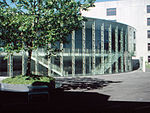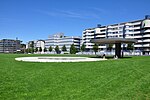Louis-Häfliger-Park
Parks in Zürich

The Louis-Häfliger-Park in Oerlikon, Zurich, covers 5,000 m2 (53,820 sq ft) and is embedded between the Regina-Kägi-Hof co-operative settlement, the existing production buildings for Oerlikon-Contraves AG, and new service buildings. It is a neighbourhood park allowing people who live or work here to relax and meet. The park is named after Louis Häfliger (1904–1993), "Saviour of Mauthausen". He saved the lives of about 40,000 inmates of the Mauthausen concentration camp.
Excerpt from the Wikipedia article Louis-Häfliger-Park (License: CC BY-SA 3.0, Authors, Images).Louis-Häfliger-Park
Paul-Grüninger-Weg, Zurich Oerlikon
Geographical coordinates (GPS) Address Nearby Places Show on map
Geographical coordinates (GPS)
| Latitude | Longitude |
|---|---|
| N 47.4125 ° | E 8.5338888888889 ° |
Address
Paul-Grüninger-Weg
Paul-Grüninger-Weg
8052 Zurich, Oerlikon
Zurich, Switzerland
Open on Google Maps









